Deploying applications
In this article, we will take a look at improvements in the user flows to deploy applications in OpenShift 4.3 Developer Perspective. You can learn more about all the improvements in the OpenShift 4.3 release here. Since the initial launch of the Developer Perspective in the 4.2 release of OpenShift, we’ve had frequent feedback sessions with developers, developer advocates, stakeholders, and other community members to better understand how the experience meets their needs. While, overall, the user interface has been well received, we continue to gather and use the feedback to enhance the flows.
The +Add item in the left navigation of the Developer Perspective is the entry point for the developers to add an application or service to their OpenShift project. The Add page offers six user flows for adding components from Git, deploying Container Images, adding an item from the Developer Catalog, importing your Dockerfile from a git repo, Importing YAML or adding a Database. Developers can easily create, build and deploy applications in real-time using these user flows.
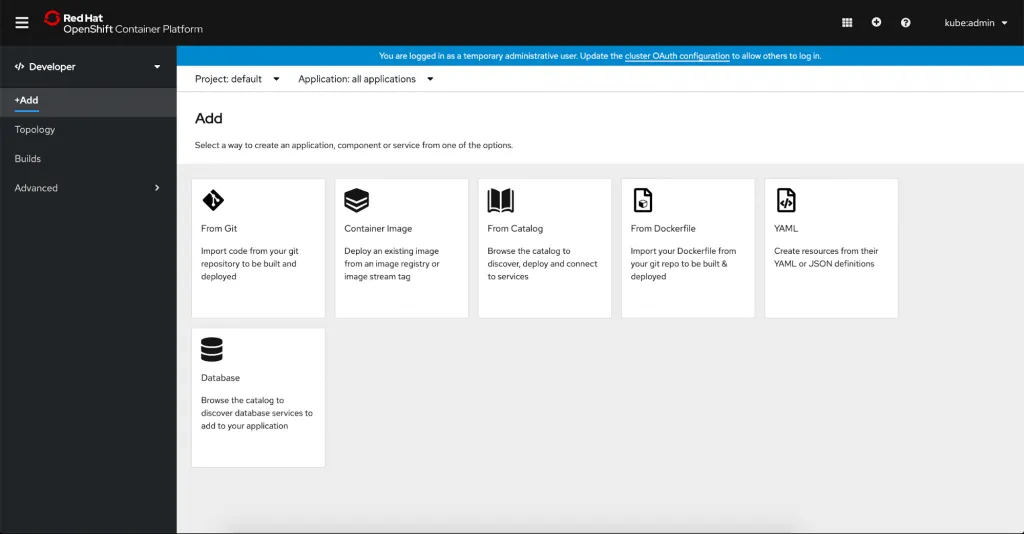
What are the improvements in 4.3?
Builder Image detection for From Git
The Import from Git flow has been enhanced to help users easily create applications by auto-filling in the details, making the process more automated. We have introduced auto-detection of the builder image, providing assistance in determining the right build strategy.
In 4.3, as soon as the user enters a Git Repo URL, validation of the URL takes place. Once the URL is validated, the builder image detection starts. The recommended builder image is indicated with a star and is selected by default.
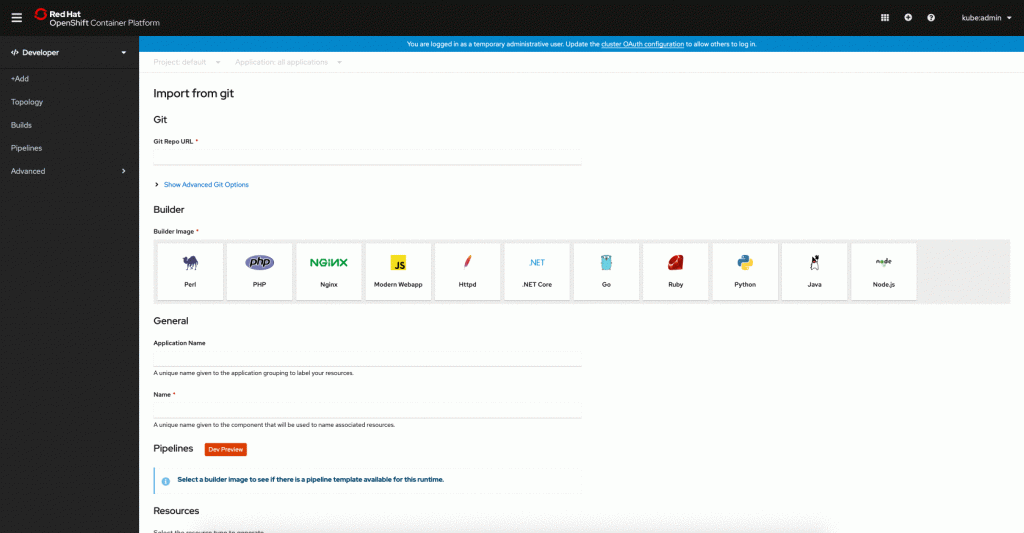
By suggesting a builder image, we are trying to reduce the number of steps it takes a user to build their application. However, the user is free to select a different builder image.To further increase the efficiency of the flow, ‘Application’ and ‘Name’ fields have smart defaults based on the ‘Git Repo URL’ entered. These fields can also be edited if they are not what the user wants. Providing the user with optional suggestions in the form fields helps the user proceed faster without mandating what they enter.
Deploy Image from Image Stream
The Deploy Image flow now offers the ability to use an image name from an internal registry to deploy an image. This option was present in the 3.11 release of OpenShift and is being reintroduced in 4.3 with some enhancements.
The user identifies the container image to be deployed by selecting the associated Project, Image Streams, and Tag in the Image section of the form.
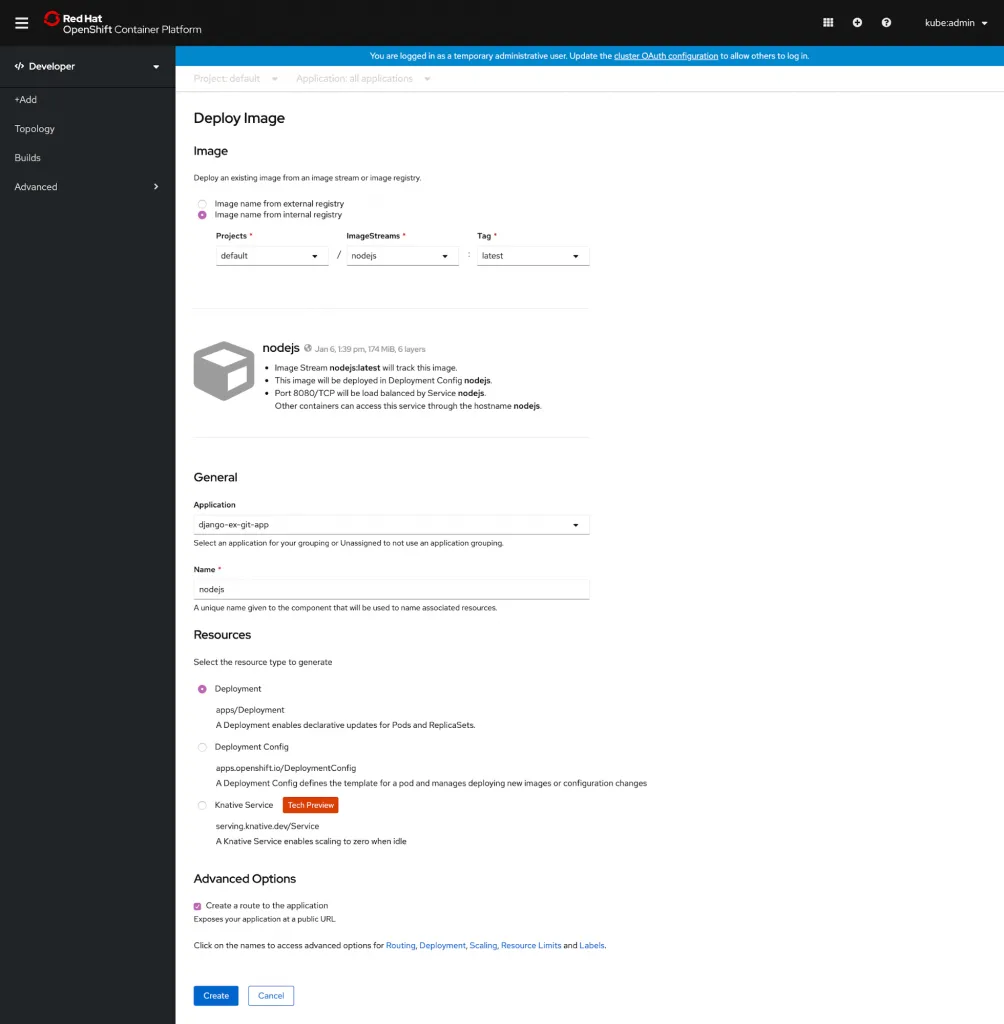
To improve this flow from 3.11, upon project selection, we verify that there is proper access to pull images from it. When there isn’t proper access, the user is able to choose to grant that access via a checkbox, which is selected by default.
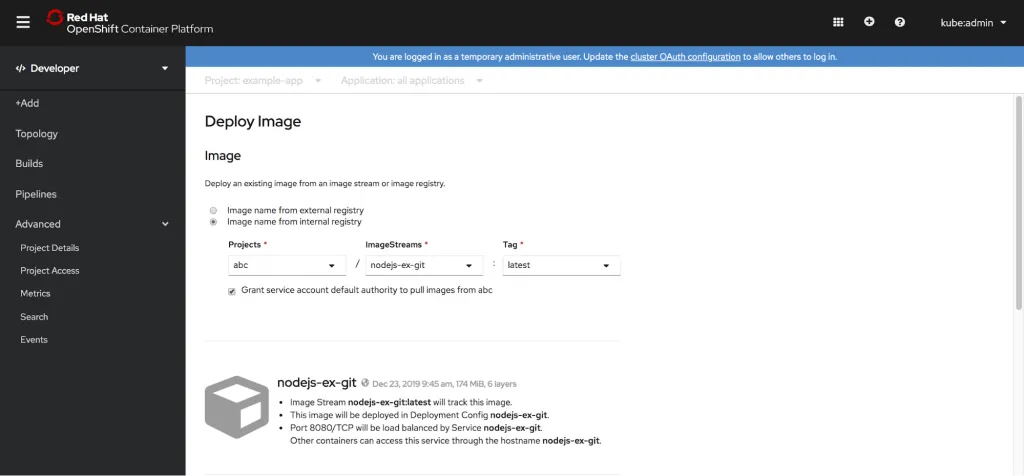
Resources section
In the 4.2 initial release of the Developer Perspective, the Import from Git, Import from Dockerfile and Deploy Image user flows created Deployment Configs by default. When the Serverless Operator was installed, a Serverless section was displayed allowing the user to select a checkbox indicating that they wanted a Knative Service created.
In 4.3, we have added a Resources section to these flows allowing the user to select what type of resource to create. By default, Kubernetes Deployments will be created. Other resource types available for selection are Deployment Config and Knative Service. The Knative Service option is only available when the OpenShift Serverless Operator is installed. Since these forms are dynamic and change based on user selections, the ‘Advanced options’ available will differ depending on the resource that is selected.
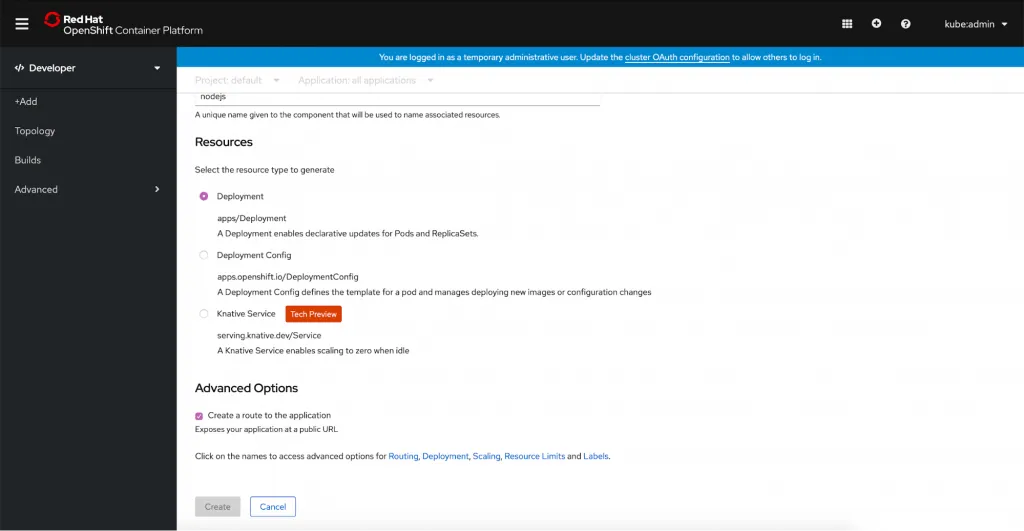
Learn More
Interested in learning more about application development with OpenShift? Here are some resources which may be helpful:
- Red Hat resources on application development on OpenShift : developers.redhat.com/openshift
Provide Feedback
- Join our OpenShift Developer Experience Google Group, participate in discussions or attend our Office Hours Feedback session
- Drop us an email with your comments about the OpenShift Console user experience.
Sull'autore
Ricerca per canale
Automazione
Novità sull'automazione IT di tecnologie, team e ambienti
Intelligenza artificiale
Aggiornamenti sulle piattaforme che consentono alle aziende di eseguire carichi di lavoro IA ovunque
Hybrid cloud open source
Scopri come affrontare il futuro in modo più agile grazie al cloud ibrido
Sicurezza
Le ultime novità sulle nostre soluzioni per ridurre i rischi nelle tecnologie e negli ambienti
Edge computing
Aggiornamenti sulle piattaforme che semplificano l'operatività edge
Infrastruttura
Le ultime novità sulla piattaforma Linux aziendale leader a livello mondiale
Applicazioni
Approfondimenti sulle nostre soluzioni alle sfide applicative più difficili
Serie originali
Raccontiamo le interessanti storie di leader e creatori di tecnologie pensate per le aziende
Prodotti
- Red Hat Enterprise Linux
- Red Hat OpenShift
- Red Hat Ansible Automation Platform
- Servizi cloud
- Scopri tutti i prodotti
Strumenti
- Formazione e certificazioni
- Il mio account
- Supporto clienti
- Risorse per sviluppatori
- Trova un partner
- Red Hat Ecosystem Catalog
- Calcola il valore delle soluzioni Red Hat
- Documentazione
Prova, acquista, vendi
Comunica
- Contatta l'ufficio vendite
- Contatta l'assistenza clienti
- Contatta un esperto della formazione
- Social media
Informazioni su Red Hat
Red Hat è leader mondiale nella fornitura di soluzioni open source per le aziende, tra cui Linux, Kubernetes, container e soluzioni cloud. Le nostre soluzioni open source, rese sicure per un uso aziendale, consentono di operare su più piattaforme e ambienti, dal datacenter centrale all'edge della rete.
Seleziona la tua lingua
Red Hat legal and privacy links
- Informazioni su Red Hat
- Opportunità di lavoro
- Eventi
- Sedi
- Contattaci
- Blog di Red Hat
- Diversità, equità e inclusione
- Cool Stuff Store
- Red Hat Summit

